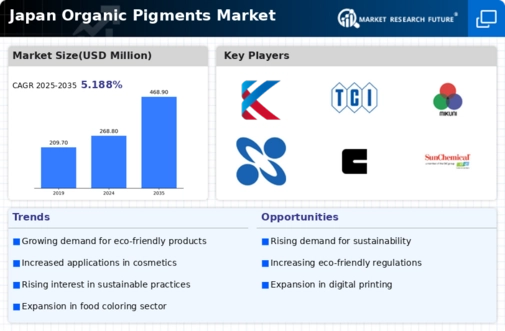The Japan Organic Pigments Market is characterized by a competitive landscape that reflects various dynamics, including innovation, product differentiation, and responsiveness to consumer demands. As global awareness around sustainability and eco-friendly practices increases, the market for organic pigments in Japan is evolving, making it essential for companies to continuously adapt their strategies to maintain and enhance their market positions. The industry is marked by a range of players that cater to diverse applications, from printing inks and coatings to plastics and textiles.
Competition is driven not only by product quality and performance but also by factors such as pricing strategies, distribution networks, and customer service capabilities, making it crucial for companies to understand their competitive edge.Yamato Chemical stands as a key player in the Japan Organic Pigments Market, known for its advanced manufacturing capabilities and strong RD focus. The company has developed a wide array of innovative organic pigment solutions that cater to the unique requirements of its customers.
Yamato Chemical’s strengths lie in its ability to produce high-quality pigments that meet stringent environmental and safety regulations, thus catering to the growing demand for sustainable products in Japan. Moreover, the company's established relationships with various industries, particularly in the paints and coatings segment, enhance its market presence and allow it to leverage opportunities effectively. T
he focus on continuous improvement and customer-centric solutions has further reinforced Yamato Chemical’s reputation and competitiveness within the organic pigments space.Sankyo Tateyama is another prominent entity in the Japan Organic Pigments Market, recognized for its comprehensive product portfolio and commitment to innovation.
The company offers a wide range of organic pigments tailored for diverse applications, including automotive, industrial coatings, and plastics, highlighting its adaptability to various market needs. Sankyo Tateyama’s strengths are rooted in its robust manufacturing processes and strategic investments in research and development, which have resulted in the creation of high-performance pigments that align well with ecological requirements. The company has actively pursued growth through mergers and acquisitions, which has expanded its capabilities and market access within Japan.
By aligning its product development with industry trends and customer preferences, Sankyo Tateyama continues to solidify its competitive stance in the organic pigments market, reflecting its proactive approach in an evolving business environment.



















Leave a Comment